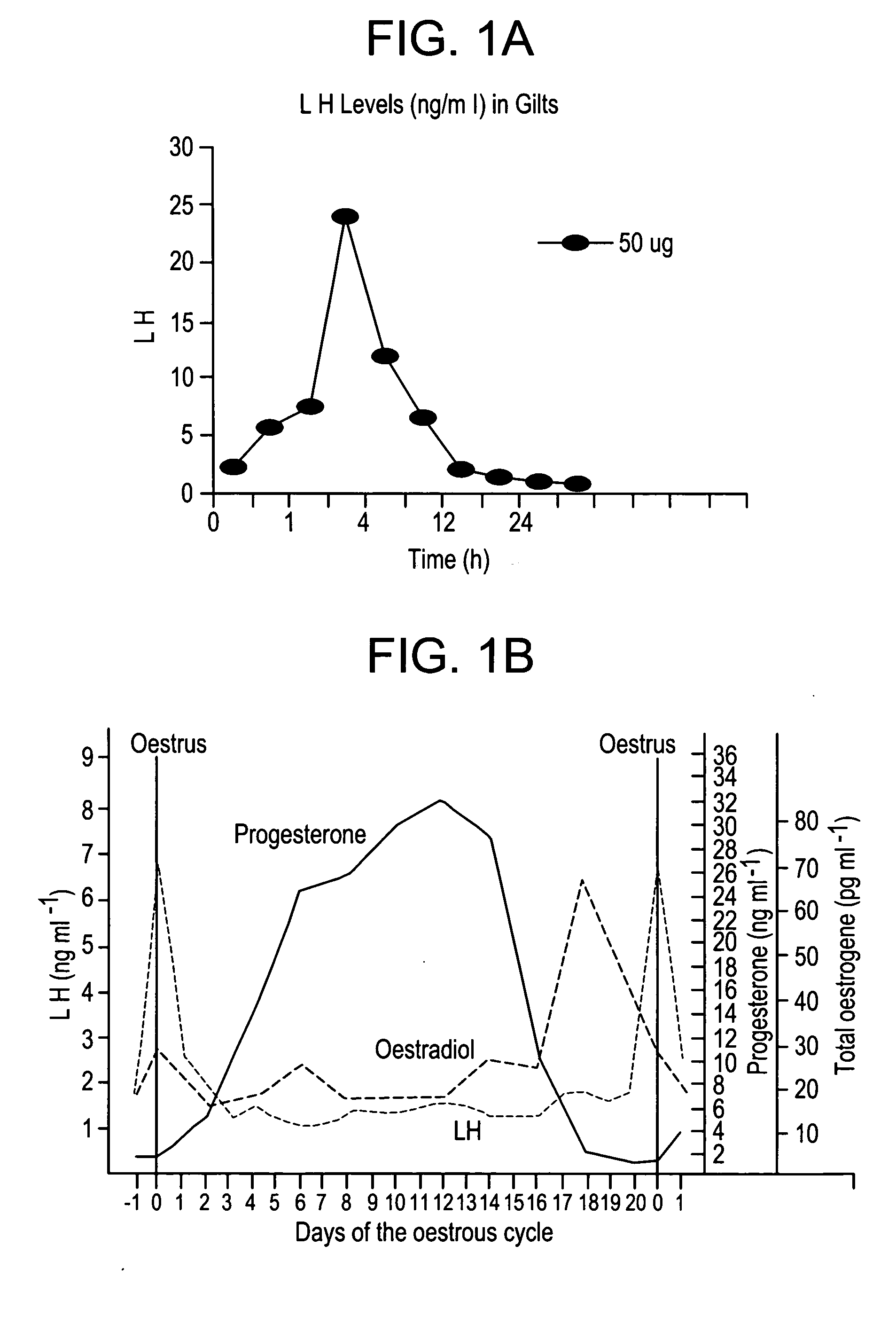Process for the synchronization of ovulation for timed breeding without heat detection
a technology of synchronization and ovulation, applied in the field of reproductive management, can solve the problems of not being able to predict the day of heat, not being able to produce and not being able to achieve high fertilization rates and viable embryos
- Summary
- Abstract
- Description
- Claims
- Application Information
AI Technical Summary
Benefits of technology
Problems solved by technology
Method used
Image
Examples
example 1
Treatment with a Single Dose of Hormone Yielded Higher Litter Sizes
[0031] A dose response study was performed using deslorelin in SAIB in an ovariectomized estrogen primed gilt model (Barb, et al. (1999) Proceed. Int'l. Symp. Control. Rel. Bioact. Mater., 26). As shown in FIG. 1a, 50 mcg of deslorelin in SAIB produced a LH peak about twice normal value, compared to Hansel et al., (1973) Biology of Reproduction 8, 222) FIG. 1b, which returned to base level by 18 hours as determined by RIA.
example 2
Comparison of Intravulvular Administration with Injection of Deslorelin
[0032] Based on these results a study was performed utilizing mature postpartum sows with 75 test individuals and 75 controls. Sows were assigned randomly in blocks of two to either control or to be injected intravulvar with 50 mcg of deslorelin in SAIB at the time of estrus detection for sows first detected in estrus in the a.m. and 12 hours later for those first detected in estrus in the p.m. Treated animals were bred AI upon detected estrus and again 24 hours later if still in estrus. Controls received a saline injection on first detected estrus behavior estrus detection and were bred according to the farm's normal procedures.
[0033] As shown in Table 1, there was no significant difference in pregnancy rates for sows of the Control versus Treated groups but there were 0.6 greater number of live piglets born per litter in the treated group versus control group.
TABLE 1Estrus and Pregnancy Rates After Deslorel...
example 3
Normal Pregnancy Rates were Attained Following Hormone Treatment in Sows
[0034] Approximately 170 postpartum sows were randomly divided into two equal groups comprised of controls and treated. Following weaning, the controls were detected for estrus and bred following the normal standard operating procedures for the farms on which they resided. The treated sows received a 50 mcg dose of deslorelin in SAIB at 96 hours post-weaning and were bred with a single insemination 28+ / −2 hours later with no regard to estrus detection. The sows were examined for pregnancy by ultrasound at 21 days and slaughtered around 28 days post breeding. The entire reproductive tract was removed and corpora lutea and embryos were counted.
[0035] The data in Table 2 demonstrates that normal pregnancy rates were attained following a single timed injection of deslorelin in SAIB, at a timed interval post-weaning, followed by a single timed insemination, in the absence of any estrus (heat) detection.
TABLE 2Pre...
PUM
| Property | Measurement | Unit |
|---|---|---|
| Time | aaaaa | aaaaa |
| Time | aaaaa | aaaaa |
| Time | aaaaa | aaaaa |
Abstract
Description
Claims
Application Information
 Login to View More
Login to View More - R&D
- Intellectual Property
- Life Sciences
- Materials
- Tech Scout
- Unparalleled Data Quality
- Higher Quality Content
- 60% Fewer Hallucinations
Browse by: Latest US Patents, China's latest patents, Technical Efficacy Thesaurus, Application Domain, Technology Topic, Popular Technical Reports.
© 2025 PatSnap. All rights reserved.Legal|Privacy policy|Modern Slavery Act Transparency Statement|Sitemap|About US| Contact US: help@patsnap.com

